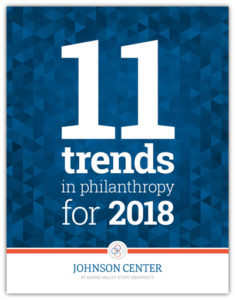Philanthropy’s Quest for Equity


Download and read the full report, featuring all 11 trends, here.
 Over the past decade, diversity, equity, and inclusion have clearly emerged as key issues in philanthropy. Monumental demographic shifts taking place in the U.S. necessitate the development of new tools and strategies that will allow the field to effectively address equity issues and impact change. This year, 2018, the majority of children in this country will be children of color (The Annie E. Casey Foundation, 2014). This shift has profound ramifications for our local communities and the national landscape if equity in access to health, education, and the workforce is not achieved.
Over the past decade, diversity, equity, and inclusion have clearly emerged as key issues in philanthropy. Monumental demographic shifts taking place in the U.S. necessitate the development of new tools and strategies that will allow the field to effectively address equity issues and impact change. This year, 2018, the majority of children in this country will be children of color (The Annie E. Casey Foundation, 2014). This shift has profound ramifications for our local communities and the national landscape if equity in access to health, education, and the workforce is not achieved.
Many foundations are striving to incorporate an equity focus into their work. The Robert Wood Johnson Foundation has been trying to better understand what foundations are doing on these issues and what they are learning (Putnam-Walkerly & Russell, 2016). Many leaders in philanthropy want to play a role in shaping social and economic policy and practice to advance this equity agenda. For instance, The Annie E. Casey Foundation has published a Race, Equity, and Inclusion Action Guide to assist organizations that work directly with systems, technical assistance providers, and communities. Additionally, The Weingart Foundation, The Ford Foundation, The California Endowment, The Consumer Health Foundation, W.K. Kellogg Foundation, and many others have all committed to applying equity principles in their work (The Annie E. Casey Foundation, 2014).
These are important efforts and have opened new dialogues and opportunities for achieving goals around equity and even social justice, but given the current disparities and challenges in our communities, is this work enough? Further critical questions philanthropy might explore include: What role does philanthropy really have in these issues of diversity, equity, and inclusion? Is that role to simply distribute charitable gifts, or is it to be more transformational? Is philanthropy a leader, or is it a follower of government, nonprofits, and industry initiatives? Is it proactive or reactive?
“What role does philanthropy really have in these issues of diversity, equity, and inclusion? Is that role to simply distribute charitable gifts, or is it to be more transformational? Is philanthropy a leader, or is it a follower of government, nonprofits, and industry initiatives?”
If philanthropy really wants to see the achievement of social justice by alleviating poverty and inequities for racial, ethnic, gender, gender orientation, religious, and ability groups, it must work collaboratively with others to address purposeful inclusion in structures of power and decision making. This collaboration should work to achieve a society in which outcomes benefit the “whole community.” It is about attaining true justice and fairness for all. Once we eliminate disadvantages created by structures and systems, we will see communities and a nation that allow all to prosper (Vedrana, 2016).
The reality is that inequities are multi-dimensional and cumulative. Untangling such complexities is a challenge we must fully embrace (UNESCO, 2016). Equity assures opportunity for all, regardless of circumstance. It assumes inclusion and sees diversity as a strength (Ross, 2017). It needs to be seen as a growth and competitiveness imperative. This will create a shared understanding of challenges and opportunities for future action (Parilla, McDearman, Donahue, & Barker, 2017).
Advancing equity through diversity and inclusion is a journey, not a destination, and one that philanthropy can help propel. Therefore, sharing knowledge, strengthening communities, and advancing opportunities for all will need to be explored over the coming years.
The Annie E. Casey Foundation. (2014). Race equity and inclusion action guide. Baltimore, MD: Author. Retrieved from http://www.aecf.org/resources/race-equity-and-inclusion-action-guide/
Parilla, J., McDearman, B., Donahue, R., & Barker, R. (2017, September 28). Building inclusive cities: A framework and lessons for local leaders. Washington, DC: Brookings Institute. Retrieved from https://www.brookings.edu/multi-chapter-report/building-inclusive-cities/
Putnam-Walkerly, K. & Russell, E. (2016). The road to achieving equity: Findings and lessons from a field scan of foundations that are embracing equity as a primary focus. Cleveland, OH: Putnam Consulting Group. Retrieved from http://putnam-consulting.com/wp-content/uploads/Equity-Field-Scan_Layout_FINAL.pdf
Ross, R. K. (2017, March 8). Philanthropy, equity, and the wizard [Web log]. The California Endowment. Retrieved from http://www.calendow.org/philanthropy-equity-wizard/
United Nations Educational, Scientific and Cultural Organization (UNESCO). (2016). World social science report – Challenging inequalities: Pathways to a just world. Paris, France: Author. Retrieved from http://unesdoc.unesco.org/images/0024/002458/245825e.pdf
Vedrana. (2016, August 1). Equality or equity toward social justice? [Web log]. Retrieved from https://pcdnetwork.org/blogs/equality-or-equity-toward-social-justice/